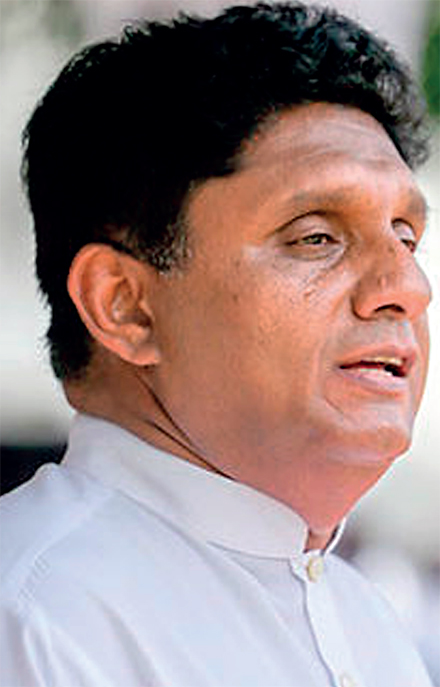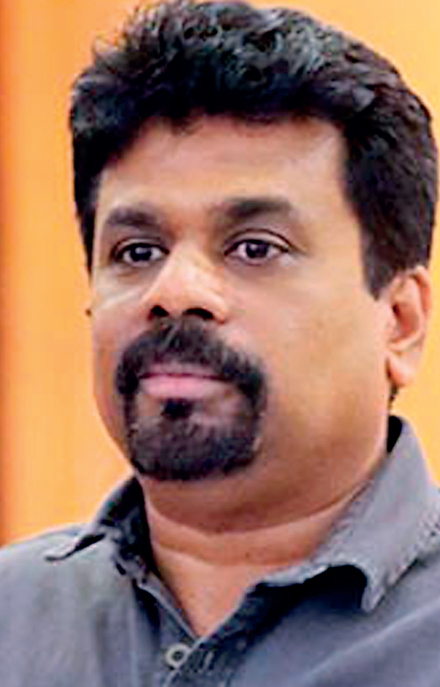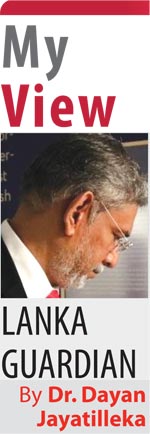Sunday Apr 27, 2025
Sunday Apr 27, 2025
Thursday, 23 December 2021 01:31 - - {{hitsCtrl.values.hits}}

The question is whether in the Gotham that Sri Lanka is set to become in 2022, Anura Kumara Dissanayake’s Red Hood will beat Sajith Premadasa’s Nightwing. What is at stake right now is who and what will be the alternative to save the people and rebuild the country in the vortex of the crisis?

Anura Kumara Dissanayake is attempting to displace Sajith Premadasa as the de facto leader of the Opposition, become the Opposition leader based on the social movement. That however, is far from the limit of the JVP’s aim for next year and beyond. The JVP is going for the gold
 A few days after US Secretary of State Antony Blinken re-emphasised the Indo-Pacific region as the most decisive single factor in determining the trajectory of our time, China made a symbolically assertive move in the Indian Ocean, south of India.
A few days after US Secretary of State Antony Blinken re-emphasised the Indo-Pacific region as the most decisive single factor in determining the trajectory of our time, China made a symbolically assertive move in the Indian Ocean, south of India.
The Chinese Ambassador in Colombo spent a few days in the island’s Tamil majority north, which is just a few miles from the southern tip of India. He was accompanied by the able representative of the PLA, and was given a more visible Sri Lankan military escort than any other ambassador.
The Chinese Ambassador also took a fast boat ride up to the last Sri Lankan point on the Indo-Lanka border in the sea.
No more hidden dragon
The symbolism was clear. Indian sensitivities notwithstanding, as far as China is concerned there are no potential areas in the intermediate zone, the zone of sensitivity of fellow Asian powers, and therefore no areas for ‘maintaining a low profile’ on the island.
China’s signalling is clear: Sri Lanka is not exclusively in India’s sphere of influence and its ethno-strategically sensitive north does not have to remain under preponderant Indian influence. The high-profile character of the Ambassador’s visit may be seen as a gesture with geostrategic implications, which the Quad will parse.
There may be a countermove. When President Chandrika Kumaratunga and International Affairs Advisor Kadirgamar briefed Prime Minister Manmohan Singh about the danger posed to India’s security by the Tiger build-up in Trincomalee, Delhi swapped the dove-ish Gopalkrishna Gandhi for the brilliant, outspoken Nirupam Sen, who then worked with Lakshman Kadirgamar – and, it must be said, the JVP – to flip the situation.
The USA regards the Indian Ocean region as a subsystem of the world system, and a subsystem of which India is the hegemon, i.e., a sub-superpower. India regards itself as a world player.
China, having built itself a solid, expanding base area on India’s northern tier, is now afforded access to the southern tier, right up to India’s border.
The timing of the Chinese Ambassador’s journey to the north, coming after Basil Rajapaksa’s visit to Delhi and despite the obvious Governmental interest in not engaging in or permitting anything that would rock the Indo-Lanka boat, shows that Sino-Indian rivalry has penetrated the Sri Lankan Government, leading to contending spheres of influence and a Cold War
within it.
The militarist element around President GR may have chosen to go all the way with China which is less concerned with its expanding role and presence in governance and whatever putschist project it may have in mind.
However, a second Myanmar on India’s doorstep will be seen differently by Delhi from the one to its East. Delhi is likely to review such a triangulation of China’s power from its own geostrategic perspective, especially if the character of the island’s power-structure changes from its long-standing democratic traditions to one where the militarist-autocratic bloc is becoming more dominant.
JVP’s game-plan
Fans of Titans (Netflix) will get it when I say that the question is whether in the Gotham that Sri Lanka is set to become in 2022, Anura Kumara Dissanayake’s Red Hood will beat Sajith Premadasa’s Nightwing.
What is at stake right now is who and what will be the alternative to save the people and rebuild the country in the vortex of the crisis: AKD and the JVP-NFF’s team and program or Sajith Premadasa and the SJB’s team and project? AKD is attempting to displace Sajith Premadasa as the de facto leader of the Opposition, become the Opposition leader based on the social movement.
That however, is far from the limit of the JVP’s aim for next year and beyond. In his commemorative speech of 13 November this year on the 32nd anniversary of the JVP’s second uprising, Anura Kumara Dissanayake referred to the years 1987-89 and significantly concluded that “…Exactly as then (“edaa vageyma”) the battle for the independence of the Motherland, the struggle for the independence of the Motherland, is before us…” (Mts 23:39-23:45, Anura Dissanayake, 13 November – https://www.youtube.com/watch?v=sO2Ou25p2Tk)
The JVP is going for the gold. The game-plan is clear, straightforward and transparently in the public domain. Its key personalities such as Anura Kumara and Wasantha Seneviratne declare their roadmap fairly openly on television and in the case of AKD and JVP Gen-Secretary Tilvin Silva, more formally at the 32nd anniversary (2021) of the Great Heroes Day of 12 November.
This is the scenario. Next will be the year of economic collapse. The masses from all social strata and areas will hit the streets. The JVP has an advantage in that it has the most powerful unions. It will bring all manner of unions including those it does not directly lead, into a single front or movement. The intellectual and professional ‘front office’ will be the Jathika Nidahas Peramuna (JNP) or National Freedom Front (NFF). Matters will move to the point of a General Strike and an August 1953 ‘hartal’ or nonviolent direct action. A Rathupaswela by the military will only cause mass outrage to escalate.
While the Old Left called off the August 1953 Hartal in two days, the JVP will not. The slogan will be the replacement of the government. The instrument will be an indefinite political general strike as the main axis of a mass uprising.
The JVP has publicly refused to negotiate a broad front with other Opposition parties because it rules out a political dialogue with “the two traditional political camps which, having wielded power for 73 years are responsible for the present catastrophic crisis”. In the literature distributed at the Grand Monarch gathering of Dec 20th, these parties were referred to as “the old doctors” (“parana veddu”).
With its control of trade unions and advantage over all other Opposition parties in the ‘ground game’, plus the availability of its national plan as launched at the event at the Grand Monarch on December 20th it will be well-positioned to project itself as the alternative government.
In his address to the nation at the 20 December Grand Monarch event – which I instantly recognised as a ‘Red Viyath Maga’ – Anura Kumara Dissanayake repeatedly proclaimed that the (JVP-driven) NFF was ready, willing and able to lead the country: “Rata baara ganna api soodaanang!”
‘“…We shall say one thing. We are ready to take up [the leadership] of this country. We’re also ready to build this country,” he said.’ (Sri Lanka’s opposition NPP ready to take up leadership: Anura Dissanayake | EconomyNext – https://economynext.com/sri-lankas-opposition-npp-ready-to-take-up-leadership-anura-dissanayake-88952/)
Can AKD-JVP-NFF succeed?
Will the JVP succeed? That doesn’t depend primarily on the Police, STF, the Gajaba Regiment or the Army’s newly-raised 1 Corps and its tough former Special Forces commander.
Tactically, it depends on whether:
(a) The JVP and FSP are tempted into launching the urban trade unions and the students into sustained action before the harvest fails and the peasant masses enter the struggle or whether the Left has the patience and discipline to await the convergence of the urban and the rural; the workers, students and peasants.
(b) The citizens will tire of strikes in the public utilities, health and transport sectors and turn to the military to restore order.
(c) The JVP and FSP can neutralise Deep State agent-provocateurs who will instigate violence and looting during mass demonstrations.
Strategically though, the JVP’s chance of success depends primarily on which of the two following propositions the majority of the country’s citizens believe:
Proposition A
Though it could have done much better, Sri Lanka has done fairly well and better than many developing countries, for most of its life as an independent state. With all the ups and downs things were reasonably alright for the most part, until the present, aberrant administration of President Gotabaya Rajapaksa, an aberrance best evidenced by the unprecedented, irrational policy on fertiliser which is ruining the agrarian sector.
Whether the proponents of Proposition A are aware of it or not, theirs is the same position that most Americans held about the Trump Presidency. Until Trump, the US system for all its faults, pretty much worked. The ultranationalist, Alt-Right Trump was the aberration and had to be seen off peacefully and democratically at all costs because his continued incumbency would have brought the US close to some form of autocracy if not fascism. The Gotabaya presidency is Sri Lanka’s equivalent.
Proposition A holds that an open economy is better than a closed economy. This does not preclude the adherents of Proposition A preferring a reformed, more equitable Open economy.
Proposition A adherents are for, or aren’t opposed to a reasonable measure of the devolution of power and self-governance to the provincial periphery as a solution to the Tamil quest for greater autonomy.
For adherents of Proposition A, there are more mainstream options than the JVP, such as the SJB and probably the SLFP. The JVP should be a strong Opposition but not the party of governance, since what the democratic system needs is a course-correction, not a change of system, which under the leadership of the JVP would be a leap in the dark.
Proposition B
The country has not experienced any real progress since 1948. The Open Economy was a mistake and has run its course. Provincial-level devolution of power is no solution to the problems of the Tamil people which can be ensured not by autonomy but by equal rights, non-discrimination and a different economic model. The two main democratic political parties/blocs have failed the people. The System is rotten and must be replaced by a new, different one. The SJB is the UNP in a mask or is a ‘shell company’ for UNP policies and is therefore an organic part of the two blocs of old traditional, conventional parties. Both these blocs, the SLPP-SLFP and the SJB must be rejected and cannot be partners in the push for a new Sri Lanka. The JVP, and its ally the NFF, is the sole possessor of the solution and is the sole solution.
The case for Proposition A is not self-evident, it has to be fought for, just as the case for Proposition B is relentlessly prosecuted by the JVP. Proposition A should be easy to fight for because there exists a potential combination of continuity and change. The continuity is an audit of the positive achievements of democracy since Independence and a presence of a pool of talent with experience in governance and macroeconomic development.
The change element is the presence as the main Opposition, not an untested third party, but of a new mainstream party, with a new leader and a new ideology: an explicitly social democratic project, poised between the old neoliberalism of the party it had broken from (UNP), the governing statist closed economic policies of the oligarchic ruling party (SLPP), the ultranationalist-militarism of the incumbent president and his inner circle (GR), and the homegrown nationalist-leftist project (JVP-NFF).
SJB’s self-sabotage
What then is the obstacle? Why is the going uphill for Proposition A?
The answer lies in a convergence of ideology, consciousness and political sociology. The main Opposition party has three layers: firstly, the social democratic, populist leader who was a dissident at least since 2010 in the Ranil Wickremesinghe UNP on its long downswing; secondly, an elite Establishment or old guard of Ministers and deputy ministers/state ministers from the Cabinets of Prime Minister Ranil Wickremesinghe (2001-2004, 2015-2019) who were enthusiastic conformists of the Ranil-Mangala neoliberal line of the Yahapalanaya phase; and thirdly, the superbly performing populist-democratic new comers and backbenchers (men and women) from the Yahapalanaya period.
Of the three, the problem is lodged in the second tier, which I would call the ‘Ranil enrolment’ or ‘Ranil cohort’; favourites and ideological co-thinkers who were given office during the UNP’s decline, its rapprochement with the LTTE and its ideological IDU (International Democratic Union) phase of Thatcherism and Reaganomics.
The problem is that unlike the ruptures leading to rebirths as new projects and parties as in the cases of SWRD and the SLFP, Vijaya-Chandrika and the SLMP, and MR and the SLPP, these elements have so far refused to rupture with the economic ideology, Constitutional policy and foreign policy of the utterly failed UNP of Ranil Wickremesinghe, and espouse views on a continuum with him, rather than with the declared social democratic vision of their party leader Sajith Premadasa, building on the developmental heritage of President Premadasa. Their invocation of a ‘social market economy’ derives not from the Social Democrats but from Konrad Adenauer and the German Christian Democrats.
It is the policy discourse secreted by this second tier that makes the SJB an easy target for Anura Kumara Dissanayake and the JVP-NFF, clearing the space for Proposition B.
Sajith plus social democracy
There are a few ex-Ranil-Chandrika demagogues in the SJB who publicly argue for the abolition of the executive presidency. That argument is based on the idea that democracy is better served by a parliamentary system and that the presidency permits any autocrat to assume the highest office.
In Chile, which had the hideous experience of the Pinochet dictatorship, no democrat advocated the abolition of the presidency. A few days ago, Gabriel Boric, a young leftist was elected to presidential office (the youngest ever in Chile) by a handsome majority and is expected to make changes in Chile’s free-market system.
“…With 56% of the votes, Gabriel Boric handily defeated by more than 10 points lawmaker José Antonio Kast...Boric’s ambitious goal is to introduce a European-style social democracy that would expand economic and political rights to attack nagging inequality…” (https://apnews.com/article/elections-caribbean-donald-trump-chile-santiago-5fc78a1fe1cb26a06839e8a7b59c8730)
Boric is the latest Latin American leftist to win the presidency recently, in what is called Pink Tide 2.0. Chile’s upcoming new constitution will doubtless democratise the presidency further but no progressive anywhere calls for the replacement of an elected presidency with a parliamentary system. From Chile under Allende to Biden today, the legislature has been the stronghold of the reactionary Right, impeding the measures of a progressive presidency.
While Boric won by 10%, Sajith Premadasa lost to Gotabaya Rajapaksa by 10% in 2019. He still offers the best chance to beat GR or any sibling or family member. Sajith’s 2019 performance also makes the presidential election the best chance to defeat the Government.
The prospect and project of a Sajith Premadasa presidency:
(a) Offers the best chance of the revival of the development paradigm and pro-people programs of President Ranasinghe Premadasa and the speedy delivery of equitable socioeconomic upliftment.
(b) Is the real hope the SJB can offer the people. If not for a Sajith presidency, why vote SJB?
(c) Is the main comparative advantage (the selling-point) the SJB has in a four-way split – SJB, SLPP, JVP, SLFP.
A crucial variable is the SLFP of ex-president Sirisena. Since 1994 it has been mostly holding the presidency and is now in a coalition, and has accumulated experience in successful governments. It has wartime patriotic legitimacy and an electoral base. The SJB would benefit from the mature, moderate SLFP, rather than a rancid, reactionary UNP, as partner.
Discover Kapruka, the leading online shopping platform in Sri Lanka, where you can conveniently send Gifts and Flowers to your loved ones for any event including Valentine ’s Day. Explore a wide range of popular Shopping Categories on Kapruka, including Toys, Groceries, Electronics, Birthday Cakes, Fruits, Chocolates, Flower Bouquets, Clothing, Watches, Lingerie, Gift Sets and Jewellery. Also if you’re interested in selling with Kapruka, Partner Central by Kapruka is the best solution to start with. Moreover, through Kapruka Global Shop, you can also enjoy the convenience of purchasing products from renowned platforms like Amazon and eBay and have them delivered to Sri Lanka.
Discover Kapruka, the leading online shopping platform in Sri Lanka, where you can conveniently send Gifts and Flowers to your loved ones for any event including Valentine ’s Day. Explore a wide range of popular Shopping Categories on Kapruka, including Toys, Groceries, Electronics, Birthday Cakes, Fruits, Chocolates, Flower Bouquets, Clothing, Watches, Lingerie, Gift Sets and Jewellery. Also if you’re interested in selling with Kapruka, Partner Central by Kapruka is the best solution to start with. Moreover, through Kapruka Global Shop, you can also enjoy the convenience of purchasing products from renowned platforms like Amazon and eBay and have them delivered to Sri Lanka.